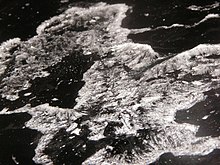K-hole

At sufficiently high doses of the dissociative anesthetic ketamine (60-125 mg IM, 100-250 mg insufflated) it is common to experience the "K-hole". This is a slang term for a subjective state of dissociation from the body which may mimic the phenomenology of schizophrenia,[1] out-of-body experiences (OBEs) or near-death experiences (NDEs),[2] and is often accompanied by feelings of extreme derealization, depersonalization and disorientation, as well as temporary memory loss and vivid hallucinations.
Ketamine and its subjective effects were related by Timothy Leary to the eighth and final circuit of his eight-circuit model of consciousness, along with DMT and high doses of LSD. The experience of the K-hole may also be similar to experiences brought on by ingesting Salvia divinorum, which, like ketamine, is a dissociative exhibiting atypically psychedelic effects.
Description
Experience of the K-hole is, like many psychedelic experiences, highly subjective, and Ketamine's effects may vary greatly between individuals. Often set and setting, the use of other drugs (prescribed or otherwise), as well as the user's physiology, psychology, personality and brain chemistry are among many defining factors which may affect an individual's personal experience of a K-hole, as well as other altered states of consciousness in general.
An individual's impression of a K-hole may include distortions in bodily awareness, such as the feeling that one's body is being tugged or is gliding on silk, flying, or has grown very large or distended. Users have also reported the sensation of their soul leaving their human body. Users have also often reported feeling more skeletal or becoming more aware of their bones - the shape of their hands is also often of interest. Users may experience worlds or dimensions that are ineffable, all the while being completely unaware of or having lost their individual identities or their sense of an extant and external world.[3] Users have reported intense hallucinations including visual hallucinations, perceptions of falling, fast and gradual movement and flying, 'seeing God', contact with non-human entities, experiencing divine forces, feeling connected to other users, objects and the cosmos, experiencing psychic connections, and shared hallucinations and thoughts with adjacent users.
Users may feel as though their perceptions are located so deep inside the mind that the real world seems distant (hence the use of a "hole" to describe the experience). Some users may not remember this part of the experience after regaining consciousness, in the same way that a person may forget a dream. Owing to the role of the NMDA receptor in long-term potentiation, this may be due to disturbances in memory formation. The "re-integration" process can be slow, and the user gradually becomes aware of surroundings. At first, users may not remember their own names, forget they are human, or even know what that means. Movement is extremely difficult, and a user may not be aware that he or she has a body at all, so being able to sit and talk is dependent upon the user and usage.
See also
References
- "In and out of the K-hole: a comparison of the acute and residual effects of ketamine in frequent and infrequent ketamine users". Addiction. 96 (5): 749–760. May 2001. doi:10.1080/09652140020039116. PMID 11331033.
{{cite journal}}: Unknown parameter|authors=ignored (help)
- ^ A James Giannini (1997). Drugs of Abuse (Second ed.). Los Angeles: Practice Management Information Corp. p. 126. ISBN 1-57066-053-0.
- ^ Drugs; Mood, Memory and Mayhem, D Corrigan, The Drug Treatment Centre Board Evening Seminar Series. 2 November 2004 (page 6)
- ^ Ketamine, Pai & Heining, Contin Educ Anaesth Crit Care Pain (2007) 7 (2): 59-63.
